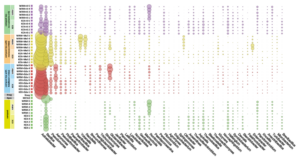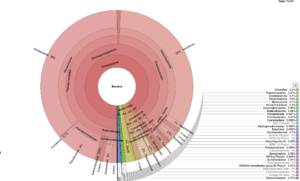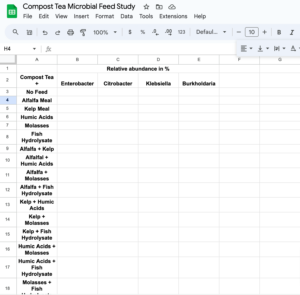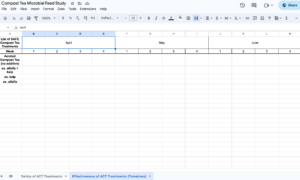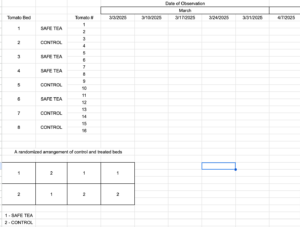Project Overview
Commodities
- Vegetables: tomatoes
Practices
- Crop Production: nutrient management, compost tea
- Soil Management: composting, soil microbiology, soil quality/health
Proposal summary:
Solutions to the problem of brewing a safe (pathogen-free) yet effective microbially-fed aerated compost tea will involve DNA-testing and testing by microscopy different kinds of microbial additives to see which microbial food does not spike pathogenic bacterial populations of Enterobacters, Citrobacters, and Klebsiella, in the compost tea yet increases the number of PGPBs.
Recent Studies of Microbial Starters for Compost
Tea
The image above is data from a study conducted by a biological amendments company in Switzerland called EdaPro.
Appendix2_2019-032_Bioinfo
The aim of the study above was to determine the diversity and identification / relative abundance of the microbiome of three compost tea samples fed varying microbial additives. The research shows that Enterobacter populations were at their highest in the brew that contained molasses (as were many beneficial bacteria).
However, in EdaPro's proprietary blend of alfalfa and kelp, there was an increase in beneficial bacteria while Enterobacter
populations remained minimal.
In DNA-testing my own vermicompost tea that was fed a variety of fish hydrolysate, humic acids, and kelp, I also saw an increase in Enterobacters which are potentially pathogenic as well as an increase in other beneficial bacteria.
Using this study as my starting point, I would like to determine the diversity and identification of the microbiome of 5 different compost tea samples fed with the following microbial foods:
- Alfalfa
- Kelp
- Fish hydrolysate
- Humic acids
- Molasses
By determining the presence, absence, and relative abundance of pathogenic bacteria, I hope to make science-based recommendations to farmers regarding the use of microbial feeds.
Project objectives from proposal:
Defining Terminology
Safe Tea - Compost tea that is brewed with an additive and found to have less than 100 CFU/100ml of Escherichia coli or 33 CFU/100ml of enterococci
Unsafe Tea - Compost tea that is brewed with an additive and found to have a significant increase of greater than 100 CFU/100ml of Escherichia coli or greater than 33 CFU/100ml of enterococci.
Safe & Effective Tea - Compost tea that is brewed with an additive and found to have a significant increase of more than 30% relative abundance in beneficial PGPBs and less than 100 CFU/100ml of Escherichia coli or 33 CFU/100ml of enterococci
Compost Tea or ACT - Aerated Compost Tea (fed or not fed)
Research Question and Objective
In this study, I aim to first and foremost answer the question, "Can we brew a safe and effective compost tea from vermicompost with the addition of microbial food?"
Through the course of the research and through copious record keeping, I also hope to answer several sub-questions such as:
1. What is the safest and most effective microbial starter to use for brewing compost tea?
2. What is the optimal brewing time to produce the safest and most effective compost tea?
3. If Enterobacters are present in my vermicompost, can proper brewing methods decrease their populations? What methods would those be?
4. Do the safest and most effective ACT treatments increase yields, disease resistance, and nutrient density in tomatoes?
In this study, I will measure the presence, absence, and relative abundance of pathogenic bacteria in 15 different treatments of compost tea from vermicompost and one control (a total of 16 compost tea treatments), brewed for 24 hours and 12 hours.
Relative abundance and identification of pathogens will be determined using DNA Testing and microbial analysis.
The compost tea treatments would be fed five different microbial starters separately and combined in pairs as shown in the table below.
| No Feed (Control) |
| Alfalfa Meal |
| Kelp Meal |
| Humic Acids |
| Molasses |
| Fish Hydrolysate |
| Alfalfa + Kelp |
| Alfalfal + Humic Acids |
| Alfalfa + Molasses |
| Alfalfa + Fish Hydrolysate |
| Kelp + Humic Acids |
| Kelp + Molasses |
| Kelp + Fish Hydrolysate |
| Humic Acids + Molasses |
| Humic Acids + Fish Hydrolysate |
| Molasses + Fish Hydrolysate |
The control will not be fed a microbial additive.
The data returned will be represented in Krona graphs and microbiome reports provided by Aggrego Data will reveal
bacteria quantities and classifications as PGPBs (beneficial bacteria) or not.
The analysis of this report will reveal the best performer as the safest and most effective compost tea.
To find out the Effectiveness of Safe Aerated Compost Tea the study will test the effects of a weekly application of the safest and potentially most effective compost tea as a foliar spray on 16 determinate tomatoes and see if the compost tea will affect tomato
- Yield
- Disease-Resistance
- Nutrient-Density
Research Hypothesis
I hypothesize that it is possible to consistently brew a safe and effective batch of aerated compost tea using specific microbial foods.
Current research suggests that molasses will prove to be the most unsafe additive to use as a compost tea feed and that either humic acids, alfalfa, and kelp, or a combination of these, may prove to be potentially safe and effective additives to use in brewing aerated compost tea (ACT).
A secondary hypothesis is that a weekly foliar application of the safest and most effective ACT treatment will deter disease, and improve yields and nutrient density in tomatoes.
Data Collection & Measurements
Before conducting research a water test will be conducted to determine that the water used for compost tea production is
pathogen-free.
Findings of compost tea treatments' microbiome identification and relative abundance of
32 samples of compost tea treatments will be logged in this spreadsheet, during the first year/phase of this
research.
Variables: Relative Abundance of Enterobacters, Relative abundance of PGPBs,
Findings of the Effects of the safest and most effective ACT treatment vs. a non-fed ACT will be stored in this second sheet
of the same spreadsheet labeled "Effectiveness of ACT (Tomatoes).
Variables: Yield, Disease resistance, Nutrient-density
A total of 32 tomatoes will be transplanted in March 2025 under hoops. Half will be treated with the safe ACT once a week
from April through September,
Tomatoes will be weighed on harvest, the onset of diseases will be noted and samples will be sent for nutrient testing to
Biounitrient Institute
Measuring Nutrient-Density in Crops
With the help of the Bionutrient Food Association
(BFA), I will send samples of harvested trialed tomatoes to the BFA labs for nutrient-dense analysis within a day after
harvest.
Bionutrient Food Association has the largest nutrition database in crops of its kind.
How Crop Testing Works
Growing partners submit food and soil samples to the Bionutrient Institute Lab and share information about how those crops were managed using the BI SurveyStack App. This app walks the user through detailed instructions on collecting food and soil samples and how to package samples for shipping. After the lab receives and processes samples, it returns a detailed report on crop and soil nutrition, comparing it against a spectrum of crops in its database.
Location and Choice and Map Plotting
The location I have chosen is the space below to be used for (6) six 6x4 beds in our production garden on our farm, Bethany Farms, 41558 Stumptown Rd., Leesburg, VA 20176.
Layout of Beds in Experiment
- Four beds designated through computer randomization will contain plantings of tomatoes and a
weekly treatment of safe compost tea will be applied will be applied as a foliar spray at the seedling stage. Each crop is numbered 1 to 16 (SAFE TEA). - Four beds designated through computer randomization will contain plantings of tomatoes and a
weekly aerated compost tea to which no feed has been added, will be applied as a foliar spray at the seedling stage. Each crop is numbered from 1 to 16. (CONTROL) - 1 represents treatments with ACT. (SAFE TEA)
- 2 represents treatments with non-fed ACT (CONTROL)
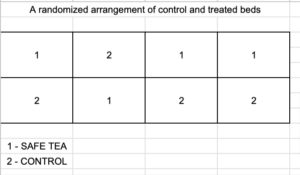
Variable: Crop Yield,
Nutrient-Density
Observations made about tomatoes in trial
